

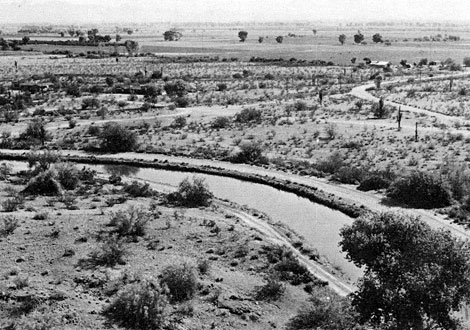 The Salt River Project's Cross Cut Canal in southwestern Scottsdale, Arizona in 1947. The landscape is primarily open desert, undeveloped, with irrigated farmland visible in the distance. Reclamation ERA photo.
The Salt River Project's Cross Cut Canal in southwestern Scottsdale, Arizona in 1947. The landscape is primarily open desert, undeveloped, with irrigated farmland visible in the distance. Reclamation ERA photo.In the 1960s, more water was used in Arizona for agriculture than for domestic and industrial purposes. Nearly all the agricultural land in Arizona required irrigation because most of the farming occurred in the southern, more arid, half of the state. Also, cotton and alfalfa--high water consumption crops--made up a large portion of the produce.
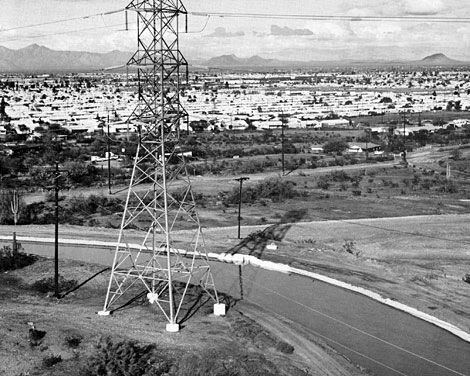 The same view of the Cross Cut Canal in 1968, showing the obvious and major encroachment of development. The increasing population portends the switch in primary water uses from agriculture to municipal and industrial use which was to come by the end of the 20th century. Reclamation ERA photo.
The same view of the Cross Cut Canal in 1968, showing the obvious and major encroachment of development. The increasing population portends the switch in primary water uses from agriculture to municipal and industrial use which was to come by the end of the 20th century. Reclamation ERA photo.The tremendous impact of population growth became evident in the 1960s, tipping the scales of water use away from agriculture and toward municipal/industrial use. The authorization of the Central Arizona Project in 1968 also augered the reduction of groundwater use and an increase in surface water use that would occur by the mid 1980s.
Groundwater and surface water withdrawals in Arizona increased from 5.4 million acre-feet in 1950 to almost 8 million acre-feet in 1970, approximately two-thirds of which was ground water. Even with deliveries from the Salt River Project, groundwater continued to be the primary source of water from 1950 to 1980, when deliveries from the Central Arizona Project began. Estimated withdrawal for agriculture was 97% in 1950 and 80% in 2000, reflecting Arizona's 600% population increase during that time period. Withdrawals for domestic water use increased more than 1,100%, beginning a trend that would continue into the future.
RECREATION
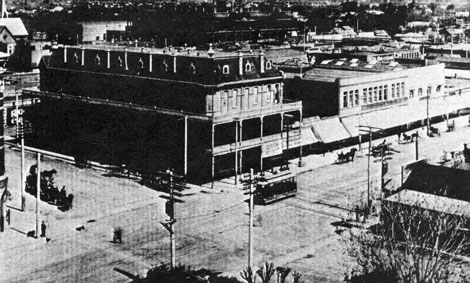 Phoenix, Arizona, from the corner of First Avenue and Washington Street, looking northeast, 1907. Reclamation ERA photo.
Phoenix, Arizona, from the corner of First Avenue and Washington Street, looking northeast, 1907. Reclamation ERA photo.The 1960s was the first decade in which recreation became an authorized use of Reclamation projects. The 1956 legislation that included authorization for construction of Glen Canyon Dam was the first to include recreation use, specifically directing planning for public recreation facilities at Glen Canyon Dam. This resulted in the world-renowned facilities at Lake Powell. Then, in 1968, the Central Arizona Project authorization also gave Reclamation direct authority to enhance recreation opportunities on lands covered by the project. The end result (Lake Pleasant and canal-side recreation along the CAP in Phoenix and Scottsdale) would be enjoyed by residents and tourists alike.
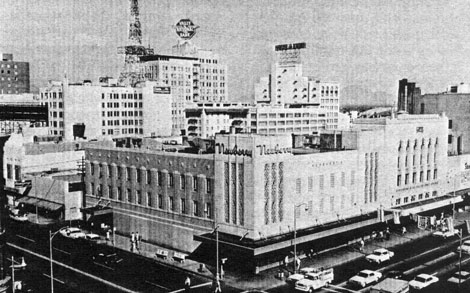 Same view, 1963. Phoenix has grown to one-half million in population. Phoenix, Arizona is in the center of Reclamation's Salt River Project. Reclamation ERA photo.
Same view, 1963. Phoenix has grown to one-half million in population. Phoenix, Arizona is in the center of Reclamation's Salt River Project. Reclamation ERA photo.
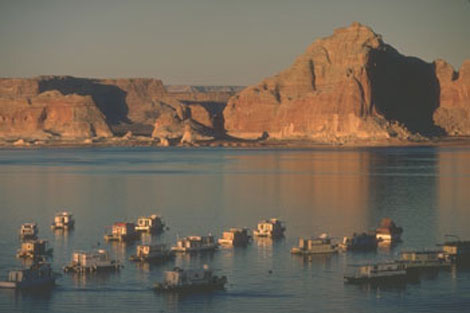 Houseboats on Lake Powell, the reservoir created by Glen Canyon Dam. In the 1960s, recreation became an authorized component of Reclamation projects. Reclamation ERA photo.
Houseboats on Lake Powell, the reservoir created by Glen Canyon Dam. In the 1960s, recreation became an authorized component of Reclamation projects. Reclamation ERA photo.
LEGISLATION THAT INCLUDES RECREATION AS A PROJECT PURPOSE - ARIZONA PROJECTS
Colorado River Storage Project (CRSP) of 1956, Public Law 84-485, 70 Stat. 105: Public Law 84-485, more specifically Section 8, authorizes and directs the Secretary of the Interior to investigate, plan, develop, operate, and maintain public recreation facilities at all CRSP projects and participating projects such as the Central Utah Project
Colorado River Basin Project Act of 1968, Public Law 90-537, 82 Stat. 885: Public Law 90-537, which includes the Central Arizona Project, provides Reclamation with direct authority to, among other things, enhance recreation opportunities on lands covered by the project.
Source: USGS report, Water Use Trends in Five Southwestern States—1950-2000 Supplement to the Arizona Water Resource, July-August 2004
Source: Annual Report on Groundwater in Arizona, Spring 1964 to Spring 1965, prepared by the USGS for the Arizona State Land Department, December 1965 https://portal.azoah.com/08A-AWS001-DWR/Omnia/PRESCOTT%20525%20Annual%20Rpt%20Groundwater%20AZ%20Spring%201964-Spring%201965.usgs.pdf
